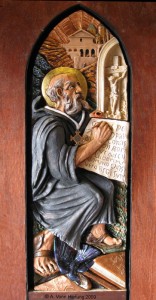St Benedict of Nursia— original ceramic sculpture by A.Vonn Hartung.
“Ora et labora“
Ora et labora (Pray and work)—refers to the Catholic monastic practice of working and praying. St. Benedict viewed prayer and work as partners, and believed in combining contemplation with action.
St. Benedict is shown here writing; this is significant for two major reasons. One, because he was a scholar and he was concerned about the sharing of knowledge with the public so that they could advance and have a better life, and especially be closer to Christ and His saints.
And two, he is writing in cursive Latin, that is, he is popularizing Latin and adapting its stilted lettering style into a cursive style more easily written. This style and his use of the Vernacular became the beginnings of the Italian language we know today.
In the foreground we see a black bird, representing the Raven which saved his life when his bread was poisoned by jealous monks envious of his many superior traits and saintly concerns for those under him, which made him such a good leader.
In the background we see Monte Cassino, the monastery he founded some 40 miles south of Rome, which did so much to nourish Christian virtues and enrich European civilization. At its height, the Benedictine order could boast 37,000 monasteries.
Buy a giclee print of this ceramic sculpture
San Benito de Nursia—escultura de cerámica original por A.Vonn Hartung.
“Ora et labora”
Ora et labora (reza y trabaja)—expresa la vocación y la vida monástica benedictina de alabanza a Dios junto con el trabajo manual diario. San Benito vio la oración y el trabajo como socios, y creía en combinar la contemplación con la acción.
San Benito se muestra aquí escribiendo; esto es importante por dos razones principales. Uno, porque era un erudito y estaba preocupado por compartir conocimientos con el público para que pudieran avanzar y tener una vida mejor, y sobre todo estar más cerca de Cristo y sus santos.
Y dos, está escribiendo en latín cursivo, es decir, está popularizando el latín y adaptando su estilo de letras estilizadas en un estilo cursivo más fácil de escribir. Este estilo y su uso de la lengua vernácula se convirtieron en los inicios de la lengua italiana que conocemos hoy.
En primer plano vemos un pájaro negro, que representa al Cuervo que le salvó la vida cuando su pan fue envenenado por monjes celosos envidiosos de sus muchos rasgos superiores y preocupaciones santas por los que estaban debajo de él, lo que lo convirtió en un buen líder.
Al fondo vemos Monte Cassino, el monasterio que fundó a unas 40 millas al sur de Roma, que tanto contribuyó a nutrir las virtudes cristianas y enriquecer la civilización europea. En su apogeo, la orden benedictina podía presumir de 37.000 monasterios.

